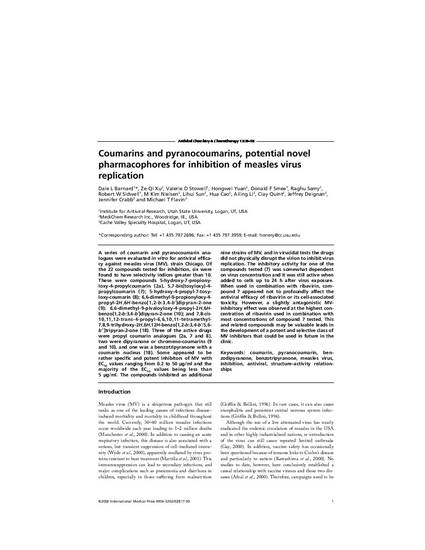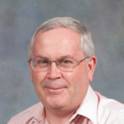
A series of coumarin and pyranocoumarin analogues were evaluated in vitro for antiviral efficacy against measles virus (MV), strain Chicago. Of the 22 compounds tested for inhibition, six were found to have selectivity indices greater than 10. These were compounds 5-hydroxy-7-propionyloxy- 4-propylcoumarin (2a), 5,7-bis(tosyloxy)-4- propylcoumarin (7); 5-hydroxy-4-propyl-7-tosyloxy- coumarin (8); 6,6-dimethyl-9-propionyloxy-4- propyl-2H,6H-benzo[1,2-b:3,4-b′]dipyran-2-one (9); 6,6-dimethyl-9-pivaloyloxy-4-propyl-2H,6Hbenzo[ 1,2-b:3,4-b′]dipyran-2-one (10); and 7,8-cis- 10,11,12-trans-4-propyl-6,6,10,11-tetramethyl- 7,8,9-trihydroxy-2H,6H,12H-benzo[1,2-b:3,4-b′:5,6- b′′]tripyran-2-one (18). Three of the active drugs were propyl coumarin analogues (2a, 7 and 8), two were dipyranone or chromeno-coumarins (9 and 10), and one was a benzotripyranone with a coumarin nucleus (18). Some appeared to be rather specific and potent inhibitors of MV with EC50 values ranging from 0.2 to 50 μg/ml and the majority of the EC50 values being less than 5 μg/ml. The compounds inhibited an additional nine strains of MV, and in virucidal tests the drugs did not physically disrupt the virion to inhibit virus replication. The inhibitory activity for one of the compounds tested (7) was somewhat dependent on virus concentration and it was still active when added to cells up to 24 h after virus exposure. When used in combination with ribavirin, compound 7 appeared not to profoundly affect the antiviral efficacy of ribavirin or its cell-associated toxicity. However, a slightly antagonistic MVinhibitory effect was observed at the highest concentration of ribavirin used in combination with most concentrations of compound 7 tested. This and related compounds may be valuable leads in the development of a potent and selective class of MV inhibitors that could be used in future in the clinic.

Antivir. Chem. Chemother. 13: 39-59. PMID: 12180648